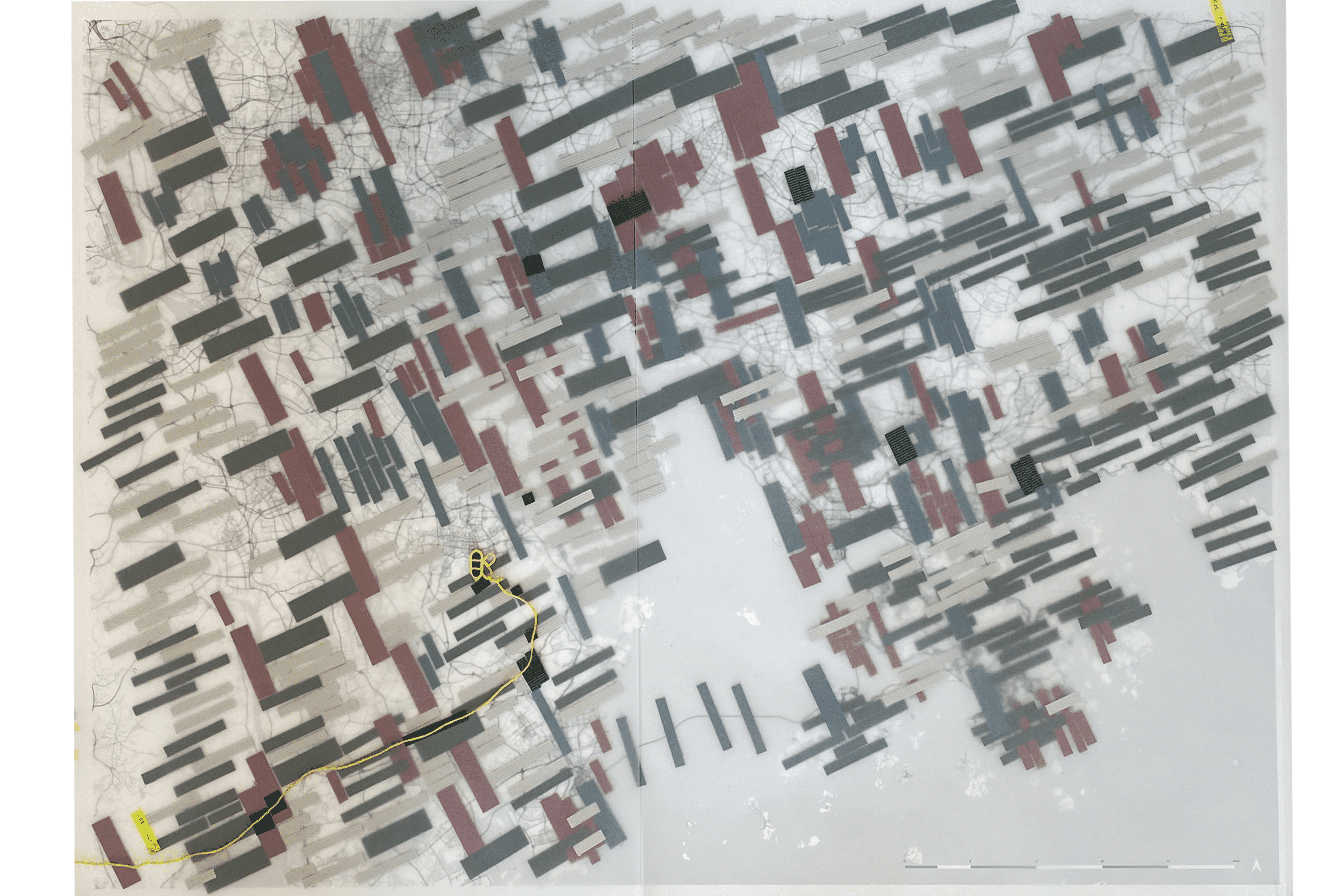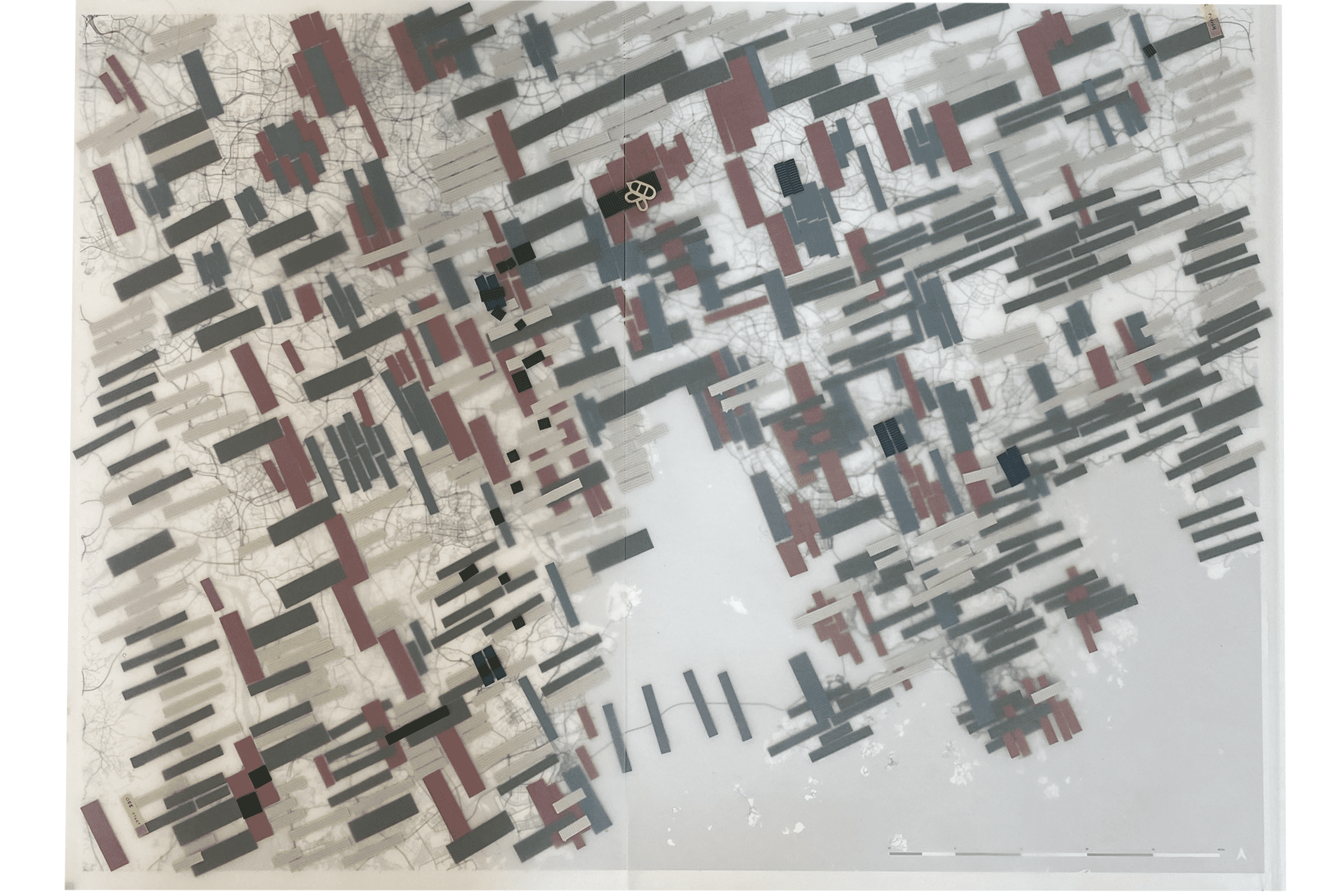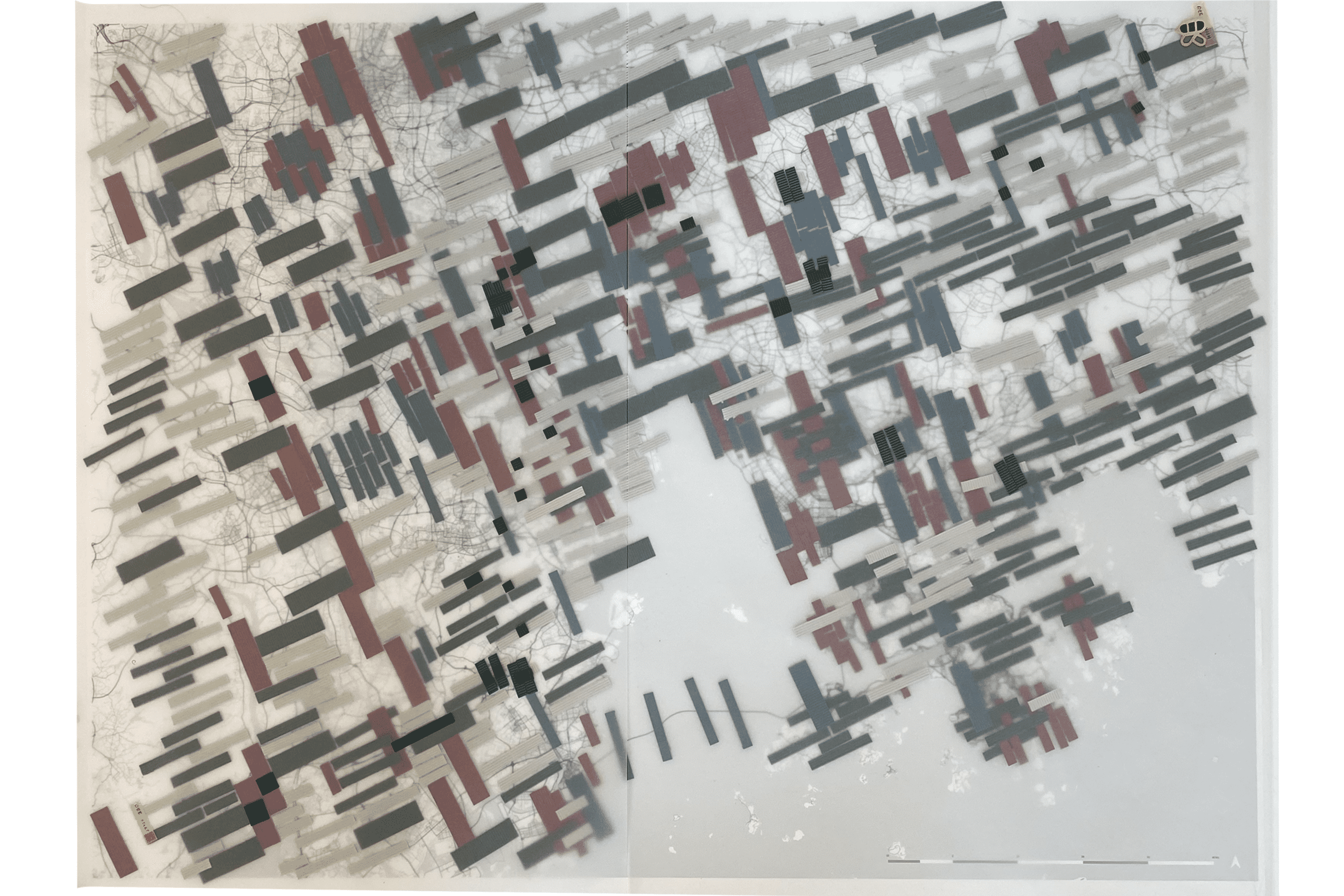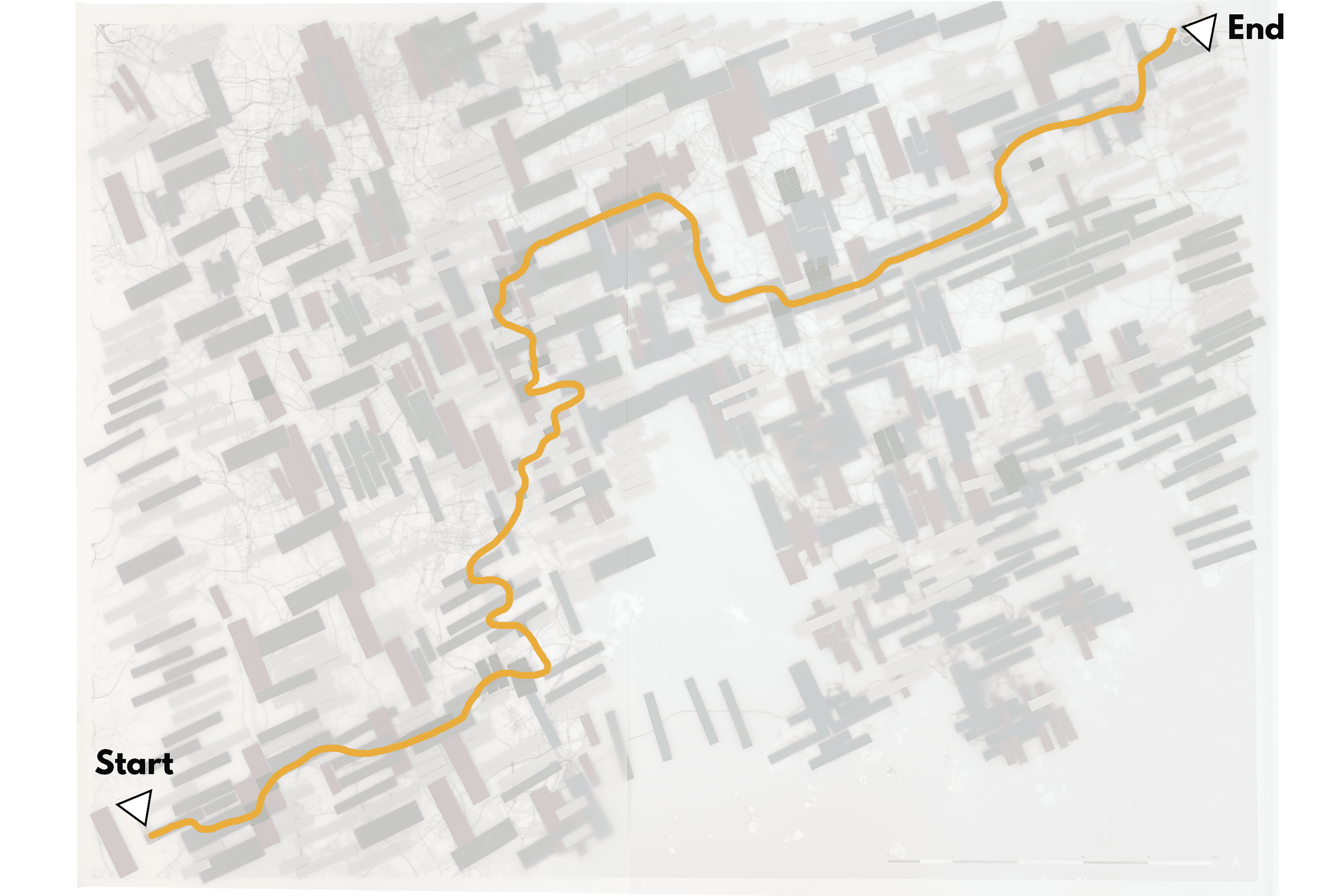Lunga Vita
Future healty city for the GBA
The Greater Bay Area has become a highly interwoven urban metropolis since the economic industrialization, reopening, and foreign economy. Compared with other cities in China, these cities expanded rapidly and achieved remarkable economic growth that fostered more opportunities for the whole nation and the world.
However, underlying the prosperity is a highly differentiated inequality and social segregation. For example, the comprehensive and accessible public resources are mainly concentrated around HK and SZ city center, especially medical resources, urban open space, and public infrastructure. The covid-19 strike brutally exposed the issues in current urban systems and made people realize our vulnerability and helped us appreciate community and togetherness, and made regional integration more imperative than ever.COVID pandemic has radically transformed how human use space, what space means, and whom the space is made for. From the social distancing of 1.5 meters to stadiums being converted to quarantine centers, and to indefinite border closures between countries and cities, the spatial-temporal structure we once knew is gone. It has caused numerous unprecedented problems, such as the discontinuation of the resource supply chain that was once highly interconnected, a sudden burst of need for medical attention due to the potential spread of diseases. Most importantly, the uneven distribution of resources exacerbates all the issues above, widening the gap between the healthy and the sick, the rich and the poor, and the urban and the rural. In order to achieve a resilient and sustainable society, health issues need to be addressed without any hesitation. On top of that is the way we distribute medical and health-related resources.
It is crucial to understand that Cities can become life-regenerative ecosystems that support what is most important: the relationship between people, their health, and the natural systems. Based on the lessons taught by Covid-19, this presents a new opportunity and an obligation for urban designers to rethink how we plan and design our urban environments—to bridge the gap between people and the place and make both more resilient and flexible to adjust to unforeseen forces that impact how cities operate as an organism.
David Sky obtained his BEng in Architecture at Shanghai Institute of Technology. Currently, he is studying Urban Environments Design at PolyU. His interests are primarily societally induced spatial issues and policy-related urban design, such as gated communities in Mainland China and Covid-19 related urban problems. Also, he is very interested in research and design to improve life quality in high-density and complex urban environments such as Kowloon. He hopes to materialize some of his design visions in the future.
Yenny Li is from mainland China. She obtained her Bachelor Degree of Landscape Architecture in Melbourne University. After spent 5 and half years studying and working in Melbourne, she found her interests in larger scopes of design thinking and the enthusiasm for learning , now she is currently studying Urban Environments Design in Hong Kong Polytechnic University. During the master study, she is fascinating about cities cultural & morphology contexts, and other societal problems existed in urban ecosystems, she spent a lot research interests and design passion in post-pandemic urbanism; how could designers redefine and reshape the urban systems for a healthier and more resilient future?
From the impervious surface change indicates urban development and can reveal significant information about urban areas; they can be utilized to quantify urban development and the spatial process of urban agglomeration. It is obvious that Shen Zhen has achieved remarkable urban growth and since 2000 it became a metropolitan city with strong centrality and influence that can also drive the development of the surrounding cities such as Dong Guan and Hui Zhou by industrial linkage and co-dependency. Yet, it is still expanding regardless of the anthropological impacts on existing GBA environment and caused disruption on ecosystems. It is also worth to mention that many built up areas in GBA have huge population but still do not have compete public facilities, sufficient resources and infrastructure as basic well being.
In 2016, the Guangdong Provincial Leading Group Office of Philosophy and Social Science Planning released the results of the survey and research on the physical health of young students in Guangdong Province. It is concluded that in the economically developed areas of the Pearl River Delta, the physical development and endurance quality are obviously poor, and they are obviously inferior to those in the mountainous areas of northern Guangdong and eastern Guangdong and Guangdong. The less developed areas in the west; the lung capacity that reflects the cardiopulmonary function of students, the Pearl River Delta as a whole lags behind these areas. And recently, the Covid-19 pandemic has challenged the existing medical system and has brought up the strains on allocation of resources.
The first iteration
In the process of the first game scenario, we were still exploring the cross morphology and tried to be accurately deliver the urban infomation by using the ‘cross’. At beginning we set a survival game based on hexagonal grid, the area with more density would have more subdivision inside. In the first game board, we assumed that nature is the resource we rely on for survival and urban resources are constantly eroding people's health. Therefore, players need to bypass the construction area to survive in the wilderness, exploring the connection between natural resources and urban facilities for survival. In the process, we discovered the gradual fragmentation of natural space and ecological values.








The second iteration
The third iteration
In the third iteration we decided to broaden our focus; what is the most different from the previous ones is that the form exploration and design of our cross has already been determined. The morphology has been through a huge transition from hexagon to the cross happening inside; so we focused on the cross symbology , centrality and complexity itself. What needs to be considered is how to classify the types of resources by colors the cross’s power and values based on our selected Covid-19 scenario, as well as how to combine it with the design values. Therefore, the synergistic effect between different colors of crosses has been officially introduced, combination with infrastructure could reinforce the medical resources and allow the players to move longer and faster, so that we could be able to achieve more testing based on the regional problems. And we also introduced one essential elements for public wellness, the Urban Green Space.
The fourth iteration
For Forth iteration, we tried to conclude what we learned from previous game scenarios, and we combined the values of nature resources, the urban green space, medical resources and infrastructure and the potential urban language and try to visualize the meaning when different levels of crosses joint together. At this stage, there is a more systematic and comprehensive way of thinking about the cross, and like a game of chess, at this stage we become clearer to understand the process of game board is to play with the urban component and develop the network’s complexity and the potential when they joining together (the cross), could be able to create profound influence not only by spatially improved the built environment, but also on social environment.
We realize that our urban system is a complex network that made by people, and the idea of Healthy City is a joint efforts by both built environment as well as the social environment.
In our post-pandemic scenario of Healthy City, 'Lunga Vita' would be achieved by joint efforts of different urban components across various planning scales. It is not only by designing healthier regional environments or achieving equitable resources and considering the multi-functionality in the urban system
but also by the potential impacts on the existing social climate and human behaviors. Healthy lifestyles could be spatially induced and integrated into daily life. With the synergistic effect of improved built environments, they would mutually improve individuals' physical and mental health, forming the community's collaborative health afterward. Then, the joint efforts between different communities would become a resilient and healthy cross-region urban network. Eventually, the whole GBA area would share the same vision of a healthier and more resilient future globalized megalopolis.
The current Tin Shui Wai area is mainly for residential, there are about 300,000 of population, with big roads but in the middle separated each 13 residential blocks. The whole region have bad permeability, the connection between each blocks such as footbridge or road-across are limited. In the zoom in 625m site area, there is only one pedastrian footbridge for 50,000 people daily usage. Once upon a time, this place is famous as “dormitary community” in HK, residents here could not really have their life, they are only living, due to low walkability and don’t have enough infrastructure, public facilities and place for small business. So creating a dynamic community is positioned as the design orientation, and the design of the future healthy and resilient home.
The pedatstrian footbridge would be the main body for all the activities happening, building a new social& mutual place for community activities and as a new multi-functional center, promoting a healthy lifestyle and provide opportunities for physical exercise, community threphetic space, community farming, and the green space would be flexible in providing exercising groundand also community health unit are spread all over the space.During Covid-19, we found that Community-based self-sufficiency and health care is an essential part of sustaining itself and provide primary care at all times; in the context of the COVID-19 pandemic, the distinct capacity of trusted community members for social engagement and delivering care where it is needed is ever more critical.
By offering the chances for necessary activities such as market space with historical texture on the foot bridge, community medical units would also promote the optional activities of physical mobility and exercising in the space. the space is convenient for residents to use, build sheds in the public space,provide a pleasant environment for the mobile market, and combine with the landscape; The total service is mainly based on community medical and health services, retaining the original disease prevention and control center, and planning to deepen the medical treatment within the community.
We zoomed into the Shenzhen-Huizhou bordering area, and according to the background understanding from the first phase, we learned that one key hindrance to resource self-sufficiency is not the adequacy, but the logistics, which is influenced by the administrative boundary, an artificial and intangible line that separates two regions. Through field mapping, we found that the border is where the subway ends due to governance issues, and given some recent news that due to the two cities having different COVID policies, the border can be suddenly closed, literally blocking all resources and human flows. Therefore, we established an urban buffer zone sandwiched between two cities and blurred the original border, facilitating the passage of material and human flow. Thus, the residents can enjoy the resources of both cities hassle-freely, whether it’s medical resources, urban green space, or mixed-use centers. Without the invisible barrier of administration boundary, the resources from one city can belong to both cities, and available resources is multiplied, paving the fundaments of healthy cities in which the basic access and availability of resources is an unignorable prerequisite.
We zoomed in to the Longhua area, and through the analysis of the first and second phases, we found that the traffic condition here is messy and the economic status is terrible. We found that buildings in the area are both old and low through field mapping. Therefore, when designing, we first build compact road infrastructure to link different regions tightly, then establish more transportation options, such as light trams and pedestrian bridges, and working areas to improve their economic level. And finally, based on our theme, we design a healthy city, adding more accessible and permeable greenery, infrastructure, and hospitals of the right size evenly distributed across the region. We hope that in the development of Longhua, we decide to increase the working area with convenient transportation, promote the local economic development, increase the urban greening in the densely populated places, and promote the construction of a high-quality compact community that is more compact, accessible and greener. Finally, the future development of Longhua will be more closely linked with each functional division, and residents no longer have to commute to other areas to work so that Longhua achieves self-sufficiency in jobs and economic opportunities.
“Lunga Vita” is an Italian phrase meaning “Praise the life”, and this is what we are pursuing, after all, to ensure all citizens’ fundamental right to be healthy and happy, which is also what the UN has been trying to promote in the SDG: good health and well-being, reduced inequalities and sustainable cities and communities. In order to do that, we address typical issues such as the inequality of resource distribution, especially the medical resources, inadequate access to green space, and artificial obstacles of administrative boundaries that prevent resources from being shared and block natural human flow. Thus, the GBA urban agglomeration would stride towards a healthy integration where easy access to medical and natural resources is no longer a dream but a fulfilled basic right.
© deltamegaregions.net